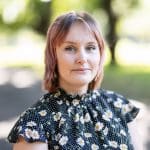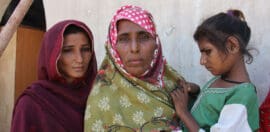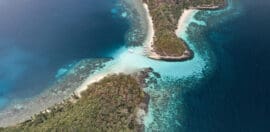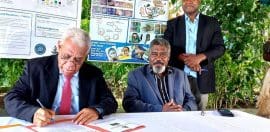Australian NGOs enabling disability-inclusive disaster prep in Pacific

9 March 2023 at 10:12 am
NGOs and governments are partnering with communities on the ground to deliver inclusive responses to disasters in countries like Fiji, Solomon Islands, Vanuatu and PNG and Timor-Leste.
Research shows people with disability are disproportionately impacted by natural disasters like fires, floods and cyclones.
In the Pacific region, work is underway to ensure that even in times of climate crisis, vulnerable communities aren’t left behind in the preparations, evacuations and rebuild.
Karen Alexander, advisor at CBM Global Inclusion Advisory Group, told Pro Bono News disability-inclusive disaster risk reduction (DIDRR) in the Pacific is facilitated by a number of partners.
The Australian government funds a form of DIDRR in the Pacific through partnerships with NGOs called the Australian Humanitarian Partnership (AHP).Iit sees government funding flow to the humanitarian programs of Australian NGOs, including in the area of disaster resilience. Work is carried out in Fiji, Solomon Islands, Vanuatu and PNG and Timor-Leste.
The Australian Department of Foreign Affairs and Trade (DFAT) also supports the Pacific Disability Forum, a network of 71 organisations by and for people with disability in 22 Pacific Island nations and territories.
CBM partners with members of the forum, including Plan, Oxfam and World Vision, on a number of projects in the Pacific that aim to centre people with disability.
AHP introduced a program called Disaster READY, which equips communities with the knowledge and resources to manage and mitigate disasters. It was initially funded to 2020, but after seeing success, the program was extended for five years with a new focus on women and girls, and people with disability.
Alexander said the program facilitated paid staff members in Disabled People’s Organisations (DPOs) to work with governments and NGOs to make disaster risk reduction more disability inclusive. The program is currently developing disability inclusive plans for each NGO.
Broadly, across the Pacific, she said a framework had been developed for disaster risk reduction and climate change adaptation, which states that “all processes need to be disability inclusive”.
But in practice, this isn’t always the case.
“For example, in the Pacific, most evacuation centres are schools and most of the schools aren’t accessible. Often people get evacuated to the local school, but people with wheelchairs or any kind of mobility issue can’t get in — so they’ll often choose to stay home,” she said.
“There’s been, sadly, examples of people dying in their homes because they couldn’t safely evacuate, or maybe the evacuation centre is accessible but there’s no transportation offered, so they can’t get there.”
Other people choose not to go to evacuation centres because they don’t feel included, especially those who experience more stigma and discrimination around their disability or difference like members of the LGBTQIA+ community, Alexander said.
Alexander added that Cyclone Pam in 2015 highlighted inaccessibility issues for people with disability in the Pacific.
“The government didn’t even know where those people lived and what they needed. So there was no mapping done [to say] OK, there’s a person with a disability in this house, they’re going to need this kind of support to evacuate.”
Another event only reinforced this lack of preparation, she said: following a volcanic eruption in Vanuatu several years ago, people with disability were evacuated by plane without their wheelchairs and crutches to save room, leaving them displaced and without their mobility aids after the evacuation ended.
But things are changing, she said.
During Cyclone Harold, DPOs mapped people with disability in advance of the disaster and what they would need to evacuate. After the cyclone, DPOs were also able to help people purchase the assistive devices they needed to replace lost and damaged items.
But with the climate crisis exacerbating disasters in the Pacific, Alexander said it is time to have DIDRR sorted once and for all.
Inclusive disaster design
There are a number of methods used to make communities more inclusive for people with disability in times of disaster, Alexander explained.
Early warning systems usually rely on sirens or audio signals, but “there needs to be an alternative system for people who are deaf or hard of hearing”, she said.
Written materials may be inaccessible for those who are blind or have low vision.
“Often it needs to come down to community-level support,” Alexander said, explaining that individual communities will map out those in their community that need extra support in times of disaster.
“It’s just about systematising it and making it the practice that’s normal for people,” she said.
Stigmas around disabilities still cause harm, and that’s something that NGOs need to keep in mind, she said.
NGOs can also face barriers in reaching all communities in the Pacific, and need to consider how to reach rural and regional provinces to deliver their message of inclusion.
Limited technology in the region, coupled with the remoteness of some communities, just compounds the issue.
Some NGOs are working on ensuring evacuation centres like churches and schools are accessible for people with mobility issues, while others are working on how to ensure gender equity and accessibility in donations.
And, Alexander said, other NGOs are working directly with Pacific governments to help them map what will be needed for community members with disability during a disaster.
See more: Planning for needs of people with disability during disaster
The view from the ground
Maselina Iuta is an advocate with the Deaf Association of Samoa. She’s been working with the association for several years and began advocating for DIDRR after attending a meeting about climate change.
“That’s where I first learned about why it’s really important to advocate for persons with disabilities, how we really need to encourage them to understand what’s happening and what can happen in the future,” she told Pro Bono News, speaking in sign language with her interpreter and friend Annika.
“After that, I started really focusing on deaf inclusion in disaster risk reduction, because I can see when I speak to the deaf community [that] our community doesn’t understand what disaster is and what climate change is.”
Sometimes that advocacy work is hard, Iuta said; literacy is low in the deaf community in her country. Many people with disability can’t go to school.
“The education system isn’t very inclusive… when we don’t have the opportunity to learn through school, then we can’t learn how to read or write. We don’t learn about climate change.”
Her work has seen her meet with people with various types of disability across Samoa, learning about their experiences and how they can be better supported to stay safe during disasters.
The association organised a field trip last year for disabled members of the community to the local weather office, to learn about things like weather and the climate crisis.
“For our deaf community, it was the first time that they’d ever heard about any of it. Opportunities like that are really, really important [so] the deaf community can understand for themselves.”
Late last year, Iuta travelled to Canberra to meet with Minister for International Development and the Pacific, Pat Conroy.
“I was letting him know about the barriers that the deaf community experiences, talking about how sometimes the barriers… felt really insurmountable, like we just couldn’t overcome them,” she explained.
One of the examples she gave the minister is the inaccessibility of early warning systems for deaf people.
“He said he was feeling a lot of empathy and sad about how in Samoa there are challenges with access to early warning systems,” she said.
But Iuta said it was important to recognise that things are now changing in the Pacific, with work being done on inclusion and accessibility.
“Things like families really working together to support the deaf community, awareness-raising around the need to include persons with disabilities, speaking to families about using lights to get attention [during disasters]. We’ve worked closely with families to help let them know, really advocating hard for people with disabilities to be included.
“That’s what we need so that we understand we’re empowered to be able to talk about our own experiences, our own challenges.
Iuta believes working with families and communities is key to creating safer and more inclusive disaster relief.
“If a family forgets about persons with disabilities or forgets about their barriers, that’s when we see people dying. So it’s really about encouraging communities to work together, to go with persons with disabilities, not leaving them. We must come together. We must work together as a community to care for each other, including people with disabilities,” she said.
Governments also have work to do in making sure that information is accessible to the whole population, which will in turn empower people with disability.
“I think it’s starting to improve, but it’s really the first time we’re having a lot of these conversations in a meaningful way. So there’s a lot of work that needs to be done for accessibility. Sometimes we sort of try, but people with disabilities are really different — everybody has their different needs. And so it’s important that when we support one group, or the government supports one group, they remember other groups as well, and they really hear from people with diverse disabilities about their experience during other weather events so that they can make sure everyone is safe,” Iuta said.
Other recent events have shone a spotlight on accessibility.
The COVID-19 pandemic was a challenge because “there had never been interpreting at the national level before”, Iuta said.
“We worked together with Alofa, which is the National Disability Advocacy Organization for Persons with Disabilities, and they were able to advocate with us to make sure there was an interpreter sitting next to people giving national advice for the first time. And so for the first time, we actually understood what was happening on TV. Same with other disasters, we’re trying to mandate the same thing, really making sure that there are interpreters.”
The Deaf Association is also undertaking work to translate signed videos into separate videos using gestures, which can be understood by the deaf community that doesn’t use sign language. Iuta says around 60 per cent of the deaf community in Samoa doesn’t understand formal sign language.
A similar process takes place during in-person events programs, where interpreters will interpret sign language, and deaf interpreters will translate the information into gestures.
“It’s always deaf people supporting other members of the deaf community,” she said proudly.
As well as the challenge of the climate crisis and natural disasters, Iuta said the deaf community has to deal with the challenge of stigma and negative attitudes towards people with disability.
“We really just need to help each other and help other people with disabilities. It can be hard sometimes when you are trying to advocate and you get such an attitude. That’s why I’m really trying to encourage people with disabilities to present, to take leadership, to go in those different positions,” she explained.
“It’s really hard for people with disabilities. We don’t find work. We struggle with education, and sometimes that can lead to an unsupportive environment. So we’re just really working hard to fix that.
“It can be hard to know what a perfect world would look like, what a future would look like. But for us, I suppose that would be [that] persons with disabilities understand what climate change is, that it’s a fair world, [that] we have equal access to information and to safety and to programs that we’re able to lead in this environment, [and] we’re empowered to make sure of our own safety.”
She said NGOs and governments that want to help should ask the people on the ground what they need.
“Ask them what barriers they are experiencing and elevate those voices and those experiences. Sometimes persons with disabilities can be nervous to advocate for themselves and talk about their challenges. But if you can create safe environments to really speak to them about what they need, then… you can provide resources or help us develop resources that let us advocate for equal access so that all people are the same.”







